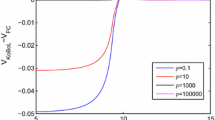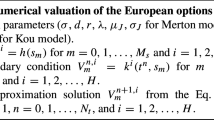Abstract
Recently, fractional partial differential equations have been widely applied in option pricing problems, which better explains many important empirical facts of financial markets, but rare paper considers the multi-state options pricing problem based on fractional diffusion models. Thus, multi-state European option pricing problem under regime-switching tempered fractional partial differential equation is considered in this paper. Due to the expensive computational cost caused by the implicit finite difference scheme, a novel implicit-explicit finite difference scheme has been developed with consistency, stability, and convergence guarantee. Since the resulting coefficient matrix equals to the direct sum of several Toeplitz matrices, a preconditioned direct method has been proposed with \({\mathcal O}(\bar {S}N\log N+\bar {S}^{2} N)\) operation cost on each time level with adaptability analysis, where \(\bar {S}\) is the number of states and N is the number of grid points. Related numerical experiments including an empirical example have been presented to demonstrate the effectiveness and accuracy of the proposed numerical method.


Similar content being viewed by others
References
Asiimwe, P., Mahera, C.W., Menoukeu-Pamen, O.: On the price of risk under a regime switching CGMY process. Asia-pacific Finan. Markets 23, 305 (2016)
Bao, J., Zhao, Y.: Option pricing in Markov-modulated exponential Levý models with stochastic interest rates. J. Comput. Appl. Math. 357, 146–160 (2019)
Black, F., Scholes, M.: The pricing of options and corporate liabilities. J. Polit. Econ. 81(3), 637–654 (1973)
Boyarchenko, S., Levendorskii, S.: Non-Gaussian Merton-Black-Scholes Theory. World Scientific, Singapore (2002)
Carr, P., Geman, H., Madan, D.B., Yor, M.: The fine structure of asset returns: an empirical investigation. J. Bus. 75(2), 305–333 (2002)
Carr, P., Wu, L.: The finite moment log stable process and option pricing. J. Financ. 58(2), 753–777 (2003)
Cartea, A., del Castillo-Negrete, D.: Fractional diffusion models of option prices in markets with jumps. Physica A 374(2), 749–763 (2007)
Chan, R., Jin, X.: An Introduction to Iterative Toeplitz Solvers. SIAM, Philadelphia (2007)
Chen, M., Deng, W.: High order algorithms for the fractional substantial diffusion equation with truncated Lévy flights. SIAM J. Sci. Comput. 37(2), A890–A917 (2015)
Chen, W., Wang, S.: A penalty method for a fractional order parabolic variational inequality governing American put option valuation. Comput. Math. Appl. 67(1), 77–90 (2014)
Chen, W., Xu, X., Zhu, S.: A predictor-corrector approach for pricing American options under the finite moment log-stable model. Appl. Numer. Math. 97, 15–29 (2015)
Chen, X., Wang, W., Ding, D., Lei, S.: A fast preconditioned policy iteration method for solving the tempered fractional HJB equation governing American options valuation. Comput. Math. Appl. 73, 1932–1944 (2017)
Cont, R., Tankov, P.: Financial Modelling with Jump Processes. CRC press, London (2003)
Elliott, R.J., Osakwe, C.J.U.: Option pricing for pure jump processes with Markov switching compensators. Financ. Stoch. 10, 250 (2006)
Gohberg, I., Olshevsky, V.: Circulants, displacements and decompositions of matrices. Integr. Equat. Oper. Th. 15, 730–743 (1992)
Guo, X., Li, Y.: Valuation of American options under the CGMY model. Quant. Financ. 16, 1529–1539 (2016)
Guo, X., Li, Y., Wang, H.: A high order finite difference method for tempered fractional diffusion equations with application to the CGMY model. SIAM. J. Sci. Comput 40, A3322–A3343 (2018)
Guo, X., Li, Y., Wang, H.: Tempered fractional diffusion equations for pricing multi-asset options under CGMYe process. Comput. Math. Appl. 76, 1500–1514 (2018)
Itkin, A., Carr, P.: Using pseudo-parabolic and fractional equations for option pricing in jump diffusion models. Comput. Econ. 40, 63–104 (2012)
Kazmi, K., An, IMEX: Predictor–corrector method for pricing options under regime-switching jump-diffusion models. Int. J. Comput. Math., pp. 1–21 (2018)
Lei, S., Huang, Y.: Fast algorithms for high-order numerical methods for space-fractional diffusion equations. Int. J. Comput. Math. 94, 1062–1078 (2016)
Lei, S., Sun, H.: A circulant preconditioner for fractional diffusion equations. J. Comput. Phys. 242, 715–725 (2013)
Lei, S., Wang, W., Chen, X., Ding, D.: A fast preconditioned penalty method for American options pricing under regime-switching tempered fractional diffusion models. J. Sci. Comput. 75, 1633–1655 (2018)
Meng, Q., Ding, D., Sheng, Q.: Preconditioned iterative methods for fractional diffusion models in finance. Numer. Meth. Part Differ. Equ. 31(5), 1382–1395 (2014)
Momeya, R.H., Morales, M.: On the price of risk of the underlying Markov chain in a regime-switching exponential Levý model. Methodol. Comput. Appl. Probab. 18, 107 (2016)
Plemmons, R.J.: M-matrix characterizations.I–nonsingular M-matrices. Linear Algebra Appl. 18(2), 175–188 (1977)
Rambeerich, N.A., Pantelous, A.: A high order finite element scheme for pricing options under regime switching jump diffusion processes. J. Comput. Appl. Math. 300, 83–96 (2016)
Saad, Y., Schultz, M.: GMRES: A generalized minimal residual algorithm for solving nonsymmetric linear systems. SIAM J. Sci. Statist. Comput. 7 (3), 856–869 (1986)
Tour, G., Thakoor, N., Khaliq, A.Q.M., Tangman, D.Y.: COS Method for option pricing under a regime-switching model with time-changed Levý processes. Quant. Financ. 18, 673–692 (2018)
Wang, W., Chen, X., Ding, D., Lei, S.: Circulant preconditioning technique for barrier options pricing under fractional diffusion models. Int. J. Comput. Math. 92(12), 2596–2614 (2015)
Yousuf, M., Khaliq, A.Q.M., Alrabeei, S.: Solving complex PIDE systems for pricing American option under multi-state regime switching jump–diffusion model. Comput. Math. Appl. 75, 2989–3001 (2018)
Zhang, H., Liu, F., Chen, S., Anh, V., Chen, J.: Fast numerical simulation of a new time-space fractional option pricing model governing European call option. Appl. Math. Comput. 339, 186–198 (2018)
Zhang, H., Liu, F., Turner, I., Chen, S.: The numerical simulation of the tempered fractional Black-Scholes equation for European double barrier option. Appl. Math. Model. 40(11), 5819–5834 (2016)
Zhang, H., Liu, F., Turner, I., Chen, S., Yang, Q.: Numerical simulation of a Finite Moment Log Stable model for a European call option. Numer. Algor. 75, 569–585 (2017)
Zhou, Z., Ma, J., Gao, X.: Convergence of iterative Laplace transform methods for a system of fractional PDEs and PIDEs arising in option pricing. East Asian J. Appl. Math. 8, 782–808 (2018)
Zhou, Z., Ma, J., Sun, H.: Fast Laplace transform methods for free-boundary problems of fractional diffusion equations. J. Sci. Comput. 74, 49 (2018)
Acknowledgments
The authors want to thank the reviewers and editor for their valuable suggestions which do improve the quality of this paper.
Funding
The first author is funded by Natural Science Foundation of Guangdong Province (Grant no. 2017A030313400). The second author is funded by The Science and Technology Development Fund, Macau SAR (File no. 081/2016/A2). The third author is funded by University of Macau (MYRG2018-00025-FST).
Author information
Authors and Affiliations
Corresponding author
Additional information
Publisher’s note
Springer Nature remains neutral with regard to jurisdictional claims in published maps and institutional affiliations.
Appendix
Appendix
In Appendix, the steps for obtaining \({\mathcal L}_{s} F(x,t)\) in (2) are presented. By the definition of F(x, t), we have:
where \(d_{s, 1}=\frac {V_{s}(x_{r},t)-V_{s}(x_{l},t)}{e^{x_{r}}-e^{x_{l}}}\) and \(d_{s, 2}=V_{s}(x_{l},t)-\frac {V_{s}(x_{r},t)-V_{s}(x_{l},t)}{e^{x_{r}}-e^{x_{l}}}e^{x_{l}}\). To obtain \({\mathcal L}_{s} F(x,t)\), the most difficult step is to calculate \(D^{\xi _{s},\alpha _{s}}_{+}[d_{s, 1}e^{x}]\), \(D^{\xi _{s},\alpha _{s}}_{+}[d_{s, 2}]\), \(D^{\lambda _{s},\alpha _{s}}_{-}[d_{s, 1}e^{x}]\), \(D^{\lambda _{s},\alpha _{s}}_{-}[d_{s, 2}]\). In fact, they can be obtained by the following deduction:
For European call options, by assuming that Vs(xl, t) = 0 and \(V_{s}(x_{r},t)=e^{x_{r}}-Ke^{-r(T-t)}\), we have
Hence, fs(x, t) can be obtained analytically. For European put options, fs(x, t) can be obtained similarly.
Rights and permissions
About this article
Cite this article
Chen, X., Ding, D., Lei, SL. et al. An implicit-explicit preconditioned direct method for pricing options under regime-switching tempered fractional partial differential models. Numer Algor 87, 939–965 (2021). https://doi.org/10.1007/s11075-020-00994-7
Received:
Accepted:
Published:
Issue Date:
DOI: https://doi.org/10.1007/s11075-020-00994-7
Keywords
- Implicit-explicit finite difference method
- Direct method
- Precondition
- Multi-state European options pricing
- Tempered fractional partial differential equation




